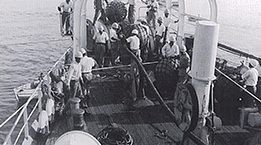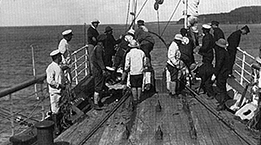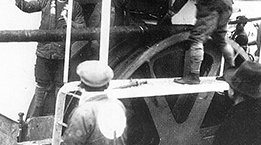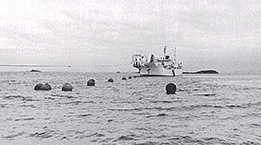
Chronology of Submarine Communication Cables in Japan
Chronology of Submarine Communication Cables in Japan




| Meiji 5 (1872) | August: |
First submarine telegraph cable (1-strand & Gutta Percha (GP) covered) was laid by the Japanese Government across the Kanmon Straits between Maeda and Amagakubo (1.1 km); two engineers, Schaefer and Jones supervised the work). |
|---|---|---|
February: |
Laying of the 2nd submarine communication cable across the Kanmon Straits between Maeda and Amagakubo. |
|
April: |
Domestic telegraphic line linked to submarine cable lines drawn in by Denmark’s Great Northern Telegraph Company. |
|
| Meiji7(1874) | August: |
Denmark’s Great Northern Telegraph Company decided to lay a submarine cable between Fukushima and Imabetsu. |
October: |
Laying of 2 submarine cables by Stownordeske across the Tsugaru Straits between Fukushima and Imabetsu |
|
| Meiji 8(1875) | February: |
Meiji-maru delivered to Yokohama from the ship builders in Glasgow in the U.K. |
June: |
First submarine telegraph cable (1-strand GP covered: 0.5 km) laid in Banyugawa Sagami. |
|
| Meiji 9(1876) | December: |
Submarine telegraph cable (1-strand & GP covered) was laid across the Bisan Straits between Shibukawa and Nou (8.2 km) |
| Meiji 10 (1877) | July: |
Repair work of submarine cable laid across the Tsugaru Straits (delegated to Denmark’s Great Northern Telegraph Company completed (First such project by the Japanese Government). |
| Meiji 11 (1878) | December: |
Submarine telegraph cable (1-strand & GP covered) No. 2 was laid across the Bisan Straits between Shibukawa and Nou (8.2 km). |
| Meiji 12 (1879) | March: |
Submarine telegraph cable No. 2 across the Bisan Straits found to be damaged by aquatic creatures; the use of teredo-protected lines started being used. |
| Meiji 15 (1882) | March: |
Submarine telegraph cable (2-strands & GP covered: 0.5 km) laid in Yamaguchi-ken, between Koujiro and Kurano (3.4 km). |
| Meiji 23 (1890) | September: |
2 submarine telegraph cable (1-strand & GP covered) were laid across the Tsugaru Straits, between Sai and Omorihama (44.7 km); this was the first submarine cable laying done entirely with a Japanese crew. The Meiji-maru was used. |
| Meiji 24(1891) | April: |
Acquisition of submarine telecommunication line between Yobuko and Izuhara from Great Northern Telegraph Company (price: 85 thousand Pound in Sterling Silver). |
July: |
Submarine telegraph cable (1-strand & GP covered) was laid across Funkawan between Sahara and Muroran (31.3 km). |
|
| Meiji25 (1892) | October: |
Submarine telegraph cable (1-strand & GP covered) was laid between Kure and Edajima (2.3 km). |
| Meiji26 (1893) | July: |
Submarine telegraph cable (1-strand & GP covered) was laid between Hirahata Nagasaki and off Goto (96.7 km). |
| Meiji27 (1894) | January: |
Submarine telegraph cable (1-strand & GP covered) was laid across the Amakusa Islands between Oyanojima and Amakusa Tsuchijima (3.5 km). |
| Meiji28 (1895) | June: |
Placement of an order for the building of Okinawa-maru to the UK |
July: |
Placement of an order for 1.678 nautical miles (3.15km) of submarine cables to the UK |
|
| Meiji29 (1896) | February: |
A cable storage facility newly erected in Nagasaki. |
April: |
Completed the shipbuilding of cable laying vessel Okinawa-maru. |
|
July: |
Okinawa-maru arrived at Nagasaki from England. |
|
August: |
Submarine telegraph cable (1-strand & GP covered) was laid across Kagoshima Ohama- Amami Island - Okinawa Island (758.0 km). |
|
December: |
Submarine telegraph cable (2-strand & GP covered) was laid across Tamai in Ehime Prefecture - Misaki in Oita Prefecture (39.4 km). |
|
| Meiji30 (1897) | May: |
Submarine telegraph cable (1-strand & GP covered - startup of current wavelength transmitters) was laid across Okinawa Island - Ishigakijima - Danshuei in Taiwan (850.1 km). |
September: |
Submarine telegraph cable (1-strand & GP covered) was laid across Teshaku Tottori - Futoi - Shiohama (91.6 km). |
|
| Meiji31 (1898) | July: |
Submarine telegraph cable No. 2 (1-strand & GP covered) was laid between Sahara and Muroran (33.4 km). |
| Meiji32 (1899) | August: |
Submarine telegraph cable (1-strand & GP covered) was laid between Kunashiri Island Hokkaido and Etorofu Island Hokkaido (58.8 km). |
September: |
Submarine telegraph cable (1-strand & GP) was laid across Wakkanai (Bakkai) - Rishiritou - Rebuntou (49.9 km). |
|
| Meiji33 (1900) | May: |
Japan’s first submarine telephone cable (8-strand & GP covered shallow water type) was laid across the Kanmon Straits, between Kuromon and Fujigayama (34 km) |
September: |
Submarine telegraph cable (1-strand & GP covered) was laid between Muroran Hokkaido and Kokugokou (38.2 km). |
|
October: |
Submarine telegraph cable (1-strand & GP covered) was laid across Tomamae Hokkaido - Yakishiri - Amauritou (29.9 km). |
|
| Meiji34 (1901) | January: |
Submarine telegraph cable (4-strand & GP covered) was laid between Suruga Kure and Yanagihara Shikoku (36.0 km). |
May: |
Submarine telegraph cable (1-strand & GP covered) was laid between Tanigawa Kagoshima and Ohama (48.5 km). |
|
| Meiji35 (1902) | January: |
Submarine telegraph cable (3-strand & GP covered) was laid between Muroseki Yamaguchi-ken and Kumage Ohita-ken (39.4 km). |
March: |
Submarine telegraph cable (1-strand & GP covered) was laid between Kouzuhana Izu and Ohshima (41.4 km). |
|
| Meiji37 (1904) | January: |
Submarine telegraph cable (1-strand & GP covered) was laid between Sasebo and Dairen (224.9 km). |
February: |
Submarine telegraph cable (1-strand & GP) was laid across Sotohama (asamo) - Kyosaitou Island - Urushibara Peninsula (147.4 km). |
|
September: |
Submarine telegraph cable (1-strand & GP) was laid across Sumijima Yamaguchi-ken - Okinoshima - Tsushima (159.4 km). |
|
| Meiji38 (1905) | May: |
Start of submarine cable laying between Kawasaki and Chichijima as part of Tokyo-Guam linkage (completed June 1906). |
July: |
Submarine telegraph cable (1-strand & GP) was laid between Enbetsu Hokkaido Toro Karafuto (100.9 km). |
|
November: |
Submarine telegraph cable (1-strand & GP) was laid across Matsue - Utsuryoutou - Gensan (866.4 km). |
|
| Meiji39 (1906) | June: |
Submarine telegraph cable (1-strand & GP covered) was laid (by Jyuuzou Oura) between Kawasaki and Chichijima Ogasawara (1235.9 km). Cable landing site was transferred to Koshinakajima Arakawa in December of the same year. |
August: |
Completed the shipbuilding of cable laying vessel Ogasawara-maru |
|
October: |
Submarine telegraph cable (1-strand & GP) was laid across Ohshima- Niijima - Miyakejima - Hachijyojima (252.8 km). |
|
| Meiji40 (1907) | January: |
Submarine telegraph cable (1-strand & GP) was laid across Imaji Shikoku- Ohshima -Hakatajima- Daisanjima - Ikukoujima (18.3 km). |
July: |
Submarine telegraph cable (1-strand & GP covered) was laid between Isono Aomori and Ohmorihama Hakodate (108.8 km). |
|
| Meiji41 (1908) | October: |
Submarine telegraph cable (1-strand & GP) was laid between Naruto and Seto (0.6 km). |
December: |
Submarine telegraph cable (2-strand & GP) was laid between Soubiraki and Shisakajima (18.8 km). |
|
| Meiji42 (1909) | June: |
Submarine telegraph cable (1-strand & GP) was laid between Dalian and Shibaso (166.1 km). Startup of public telephone service in August 16. |
July: |
Submarine telegraph cable (2-strand & GP) was laid between Takei Kagawa-ken and Azukijima (10.1 km). |
|
| Meiji43 (1910) | May: |
Submarine telegraph cable (1-strand & GP) was laid between Shinushigake Nagasaki-ken and Ohama (48.8 km). |
October: |
Submarine telegraph cable (1-strand & GP) was laid between Mogi Nagasaki-ken and Danshuei in Taiwan (1263.1 km). |
|
| Meiji44 (1911) | May: |
Submarine telegraph cable (1-strand & GP) was laid between Kyobuntou and Kouyou Peninsula Korea (67.4 km). |
| Meiji45 Taisho1 (1912) | March: |
Submarine telegraph cable (1-strand & GP) was laid between Yoshimi Yamaguchi-ken and Annam in Korea (215.7 km). |
September: |
Submarine telegraph cable (1-strand & GP) was laid between Okinawa Island - Ishigakijima and Miyakojima (160.9 km). |
| Taisho2 (1913) | October: |
Establishment of Japan-China Telegraph Accord and consequently:1. Establishment of Japan Telegraph station in Shanghai.2. |
|---|---|---|
| Taisho3 (1914) | October: |
Submarine telegraph cable (4-strand & GP) was laid between Mogi Nagasaki and mouth of the Yangtze (871.9 km). |
| Taisho4 (1915) | January: |
Completion of submarine cable between Nagasaki and Shanghai ( Cable laid between mouth of the Yangtze and Hozan, and this connected to the previously mentioned Nagasaki - mouth of the Yangtze line. Startup of Overseas Japanese language telegraph service. |
April: |
Submarine telephone cable (4-strand rubber-sheathed) was laid between Yade Okayama-ken and Ohme Kagawa-ken (13.1 km). |
|
May: |
Submarine telegraph cable (1-strand & GP) was laid between Sasebo and Tsingtao (983.2 km; cables connected Tsingtao - zhifu and mouth of the Yangtze - Rozan lines). |
|
| Taisho5 (1916) | June: |
The Shanghai - Yap submarine cable, laid by Germany in Meiji 1905, severed at the west of Okinawa, landed at Okinawa, and a link made between Okinawa and Yap (2969 km). |
| Taisho6 (1917) | July: |
Submarine telegraph cable (1-strand & GP) was laid between Mogi in Nagasaki and Danshuei in Taiwan (1292.2 km). |
September: |
Submarine cable between Tokyo and Guam modified to a Muirhead duplex transmission type. |
|
October: |
Submarine telegraph cable (1-strand & GP) was laid between Hotei in Taiwan and Penghu (72.2 km). |
|
| Taisho8 (1919) | February: |
Submarine telegraph cable No. 3 (4-strand rubber-sheathed) was laid between Yoshimi in Yamaguchi-ken and Annam in Korea (213.3km). |
| Taisho9 (1920) | July: |
Submarine telegraph cable No. 2 (1-strand & GP) was laid between Isono Aomori and Ohmorihama Hakodate (108.5 km). |
| Taisho10 (1921) | April: |
Submarine telegraph cable (1-strand & GP covered) was laid between Mogi Nagasaki-ken and Dalian (1202.0 km; managed by Ministry of Communications at Southern Manchurian Railway facility). |
| Taisho11 (1922) | November: |
Submarine telephone cable (16-strand, uniform load, lead-sheathed paper covered, made by Sumitomo) was laid between Shibukawa Okayama-ken and Nou Kagawa-ken (10.9 km). |
| Taisho12 (1923) | March: |
Completetion cable laying vessel, Nanyo-maru. |
May: |
Submarine telephone cable (4-strand, uniform load, GP, made by Furukawa) was laid between Innoshima and Mukojima (5.2 km). |
|
June: |
Submarine telephone cable (4-strand, uniform load, GP, made by Furukawa) was laid between Innoshima and Ikuchijima (1.3 km). |
|
September: |
Nanyo-maru and Okinawa-maru deployed effectively for relief of Kanto Great Earthquake victims and survivors. |
|
| Taisho13 (1924) | September: |
Submarine telephone cable (4-strand & GP) was laid between YOBUKO SAGA and Hatsuyama Iki (35.4 km) |
| Taisho15 Showa1 (1925) | February: |
Submarine telegraph cable (2-strand & GP) was laid between Murotsu Yamaguchi-ken and Ryuko Korea (215.6 km). |
April: |
Submarine telephone cable (4-strand, continuous load, balata covered) was laid between Ishizaki, Tsugaru Straits and Tobetsu (65.0 km). Telephone service between Honshu and Hokkaido started via submarine cable. |
|
November: |
Submarine cable (14-pair, uniform load, lead-sheathed paper) was laid across Shimonoseki Straits (between Sangenya and Ohtachiura, 3.6 km). |
| Showa2 (1927) | March: |
Submarine telephone cable (4-strand, uniform load, balata covered) was laid between Hiraiso Shikoku and Shuugi Ohita-ken (44.2 km). |
|---|---|---|
April: |
Submarine telegraph cable (8-strand, uniform load, lead-sheathed paper) was laid between Suruga Kure and Yanagihara Shikoku (34.1 km). |
|
| Showa3 (1928) | March: |
Submarine telephone cable (4-strand, uniform load, balata covered) was laid between Kakutahama Niigata-ken and Mushiroba Sado (38.8 km). |
April: |
Submarine telephone cable (4-strand, uniform load, balata covered) was laid between Ishizaki, Tsugaru Straits and Tobetsu (64.2 km). |
|
December: |
Submarine telegraph cable (1-strand & GP) was laid between Kouzuhama Izu and Niijima (57.5 km). |
|
| Showa4 (1929) | May: |
Submarine cables (14-pair, anti-uniform load, lead-sheathed paper) were laid between Suma, Akashi Straits and Kusumoto (17.0 km) and Amanura, Nauto Straits and Satoura (11.6 km). |
August: |
Submarine telephone cable (2-strand, uniform load, lead-sheathed paper) was laid between Oogami Saga-ken and Ohkubo Iki (30.0 km). |
|
December: |
Submarine telephone cable (4-strand, uniform load, lead-sheathed paper) was laid between Oogami Saga-ken and Katsumiura Tsushima (101.1 km). |
|
| Showa5 (1930) | December: |
Submarine telephone cable (4-strand, uniform load, lead-sheathed paper) was laid between Izumo Oashi and Iki Futoi. |
| Showa6 (1931) | May: |
Tokyo-side landing site of the Tokyo - Chichijima Ogasawara submarine cable line changed to Kamakura. Establishment of Kamakura Telegraph Relay Station. |
November: |
Carrier test made on submarine cable laid across the Straits of Korea showed positive results. |
|
| Showa7 (1932) | July: |
Submarine telephone cable (4-strand & GP) was laid between Ootsu Kanagawa-ken and Futsu Chiba-ken (16.1 km). |
October: |
Telephone call test made on submarine cable laid across the Straits of Korea (Shimonoseki - Pusan). |
|
| Showa8 (1933) | April: |
Submarine telephone cable (4-strand, GP, uniform load) was laid between Ozaki Tsushima and Annam in Korea (90.9 km). |
July: |
Carrier test made on submarine cable laid across Tsugaru Straits. |
|
| Showa9 (1934) | February: |
Submarine telephone cable (28-strand, uniform load, lead-sheathed paper) was laid between Shibukawa Okayama-ken and Nou Kagawa-ken (9.9 km). |
September: |
Submarine telephone cable (Concentric type 1-strand, gutta percha insulation) was laid between Enfutsu Hokkaido and Merei Karafuto (162.8 km). |
|
| Showa11 (1936) | October: |
Submarine telephone cable (28-pair, lead-sheathed paper, non-loaded carrier) was laid between Onoda Yamaguchi-ken and Karita Fukuoka-ken (24.6 km). |
| Showa12 (1937) | August: |
Submarine telephone cable (14-pair, lead-sheathed paper, non-loaded carrier) was laid across Fukuoka - Iki - Tsushima - Pusan (201.0 km). First time use of steel wire reinforcement. |
November: |
Cable laying vessel, Toyo-maru launched. |
|
December: |
Recovered Dalian - Shibashu line, submarine telegraph cable laid between Dalian and Tenshin (428.8 km - No. 1 laid by Ogasawara-maru). |
|
| Showa13 (1938) | June: |
Submarine telegraph cable (1-strand & GP) was laid between Penghu in Taiwan and Amoy in China (176.2) |
July: |
The cable laying vessel Okinawa-maru is retired with the completion of the Toyo-maru (Okinawa-maru is modified into a cargo vessel at Namura Shipyards, Osaka in October 1939). |
|
December: |
December: Submarine telegraph cable laid between Takao and Canton (795.2 km). |
|
| Showa14 (1939) | May: |
Submarine telegraph cable (1-strand & GP) laid between Canton and Kainantou (617.3 km). |
| Showa15 (1940) | September: |
Submarine telegraph cable (1-strand & GP) laid between Haikou in Kainantou and off French Indochina (387.7 km). |
| Showa16 (1941) | February: |
Submarine cable (30-pair, lead-sheathed paper) laid between Palau Island and Koror Island. |
April: |
Submarine telephone cable (30-strand, lead-sheathed paper) laid between Saipan and Tinian (No. 1: 11.2 km and No. 2: 13.8 km). |
|
December: |
Submarine telephone cable (28-pair, double lead-sheathed paper) was laid across Tokyo Bay, between Ootsu and Futsu Chiba-ken (19.6 km). |
|
| Showa17 (1942) | March: |
The Guam-Yap-Menado line was drawn to Palau; Palau-Yap and Palau-Menado lines opened. |
July: |
Submarine telephone cable (14-pair, lead-sheathed paper, carrier) was laid between Kure and Matsuyama (35.5 km). |
|
August: |
Submarine telephone cable (28-pair, lead-sheathed paper, carrier) was laid across Kitan Straits, between Tanyu and Shuhon (26.4 km). |
|
December: |
Hong Kong Branch of Submarine Cable Construction Department opened in occupied Hong Kong. |
|
| Showa18 (1943) | February: |
Submarine cable (4-strand, special GP, carrier) was laid across Toyogo Waterway, between Tamai and Misaki (40.2 km). |
May: |
Acquisition of Kaikou-maru (retired in July 1957). |
|
June: |
Submarine telephone cable (14-pair, non-load, lead-sheathed paper, carrier) was laid between Tanaki Tsushima and Ikeura Korea (91.0 km). |
|
August: |
Transmission stops via the submarine cable between Nagasaki and Shanghai due to damage (in Japan side). |
|
October: |
Submarine telephone cable (8-pair, lead-sheathed paper, carrier) was laid across Tsugaru Straits, between Ishizaki and Tobetsu (67.5 km). |
|
November: |
Two submarine telephone cables (4-strand, uniform load, balata insulation & 1-strand ) were laid between Enfutsu Hokkaido and Merei Karafuto (174.4 km). |
|
| Showa19 (1944) | February: |
Cable laying vessel, Toyo-maru, while doing repair work on Nagasaki - Danshuei No.2 cable, 30 nautical miles north by northwest of Kiryu, gets hit by submarine torpedo but is undamaged. |
August: |
Submarine telephone cable (14-pair, lead-sheathed paper) was laid between Katsumiura Tsushima and Hanjyou Iki (68.4 km). |
|
September: |
Submarine telephone cable (14-pair, lead-sheathed paper) was laid between Fukuoka and Okubo Iki (39.7 km). |
|
| Showa20 (1945) | February: |
Cable laying vessel, Ogasawara-maru attacked by air at Shimoda Port, Shizuoka-ken. |
May: |
Submarine telephone cable (2-pair, special GP, carrier) was laid across Tsugaru Straits, between Ishizaki and Tobetsu (64.1 km). |
|
June: |
Submarine telephone cable No.1 (28-strand, lead-sheathed paper, carrier) was laid across Toyogo Waterway, between Kanzaki and Yasuki (46.6 km). |
|
July: |
Cable laying vessel, Toyo-maru capsized after hitting mine in Taurikou, Shimonoseki Straits. |
|
August: |
Cable laying vessel, Ogasawara-maru, sinks 4 nautical miles offshore Mashige Hokkaido after being hit by a torpedo. |
|
December: |
Tsuridori-maru leased from government and used as cable laying vessel. |
|
| Showa21 (1946) | January: |
Onomichi branch of Cable Construction Department opened. |
February: |
Acquisition of Seiun-maru |
|
| Showa22(1947) | January: |
Completion of modification work on Sagami-maru. |
June: |
Submarine telephone cable (8-pair, rubber, lead-sheathed paper, carrier) was laid across Tsugaru Straits, between Ishizaki and Tobetsu (70.5 km). |
|
| Showa23 (1948) | January: |
Submarine telephone cable No. 2 (28-pair, rubber, lead-sheathed paper, no load, carrier) was laid across Kammon Straits, between Amaura and Satoura (14.0 km). |
February: |
Submarine telephone cable No. 2 (pair, rubber, lead-sheathed paper, no load, carrier) was laid across Kitan Straits, between Tanyu and Sumoto (28.0 km). |
|
September: |
Application starts of submarine electrode deep cable engineering method. |
|
October: |
Sagami-maru’s management shifted to Ship Management Association. |
|
| Showa24 (1949) | March: |
Submarine telephone cable (8-pair, non-load, lead-sheathed, carrier) was laid between Mori and Muroran (31.3 km - Cable laid across Tsugaru Straits in 1943 reused). |
| Showa25 (1950) | May: |
Submarine telephone cable (8-pair, special GP, carrier) was laid across Tsugaru Straits between Ishizaki and Tobetsu (68.8 km). |
July: |
Laying of submarine teletype cable (4-strand GP and 4-strand, balanced load, balata insulation) between Soshihama Tsushima and Ikeura Korea delegated by United Nations Forces (129.1 km). |
|
August: |
Submarine telephone cable No. 2 (14-strand, lead-sheathed paper, carrier) was laid across Toyogo Waterway, between Kanzaki and Yasuki (46.6 km). |
|
| Showa26 (1951) | September: |
Submarine telephone cable (2-pair, special GP, carrier) was laid between Tradomari Niigata and Maura Sado (48.7 km - Cable laid across Toyogo Waterway in 1943 reused). |
October: |
Submarine telephone cable (8-pair, PE, carrier) was laid between Mori and Muroran (33.2 km - First use of PE submarine cables). |
|
| Showa27 (1952) | Application of anti-corrosion armored steel wires featuring polyvinyl chloride coating. |
|
August: |
Establishment of Nippon Telegraph and Telephone Public Corporation. |
|
November: |
The Submarine Cable Construction Section, which had been under the Facilities Department, Facilities Bureau, was renamed the Submarine Cable Facility Office, due to an organizational reshuffling, and became an agency which came directly under the head office. |
